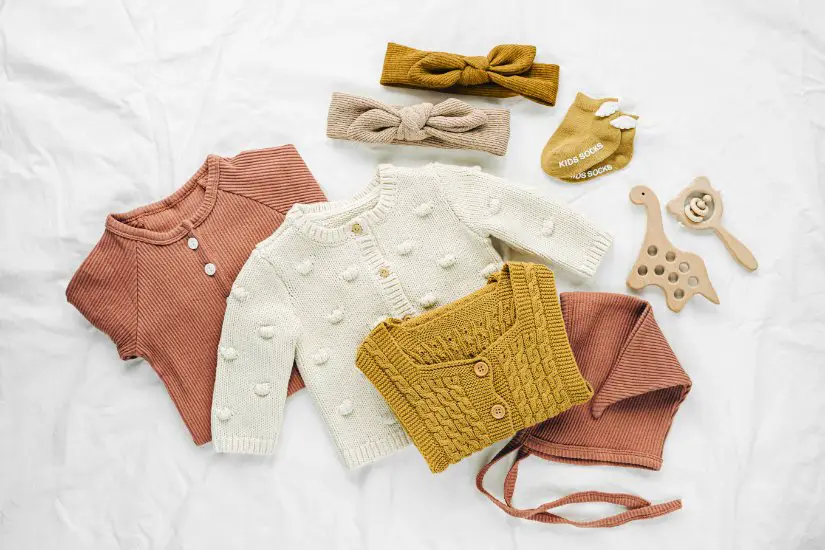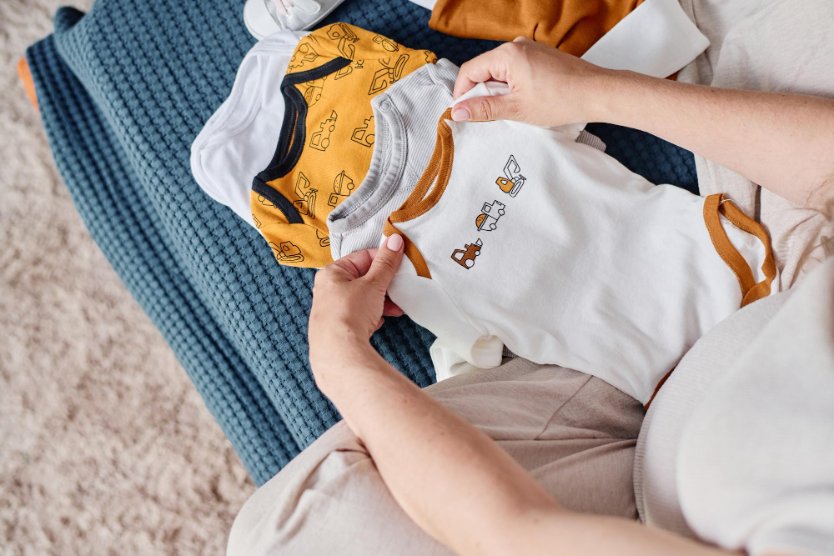Your comprehensive resource for dressing babies safely and comfortably through every season, from newborn to toddler years
Table of Contents
Choosing the right clothes for your baby as seasons change can feel overwhelming, especially for new parents. Your baby needs different types of clothing for each season to stay comfortable and safe. The right seasonal wardrobe helps protect your little one from getting too hot or cold while supporting their natural development.
Key Takeaways
- Pick weather-appropriate fabrics to keep your baby at a safe temperature
- Choose soft, breathable materials that won’t irritate sensitive skin
- Select clothes that are easy to put on and allow free movement
- Always prioritize safety features and age-appropriate designs
- Consider sustainable options for both environment and budget
Understanding Baby Wardrobe Basics
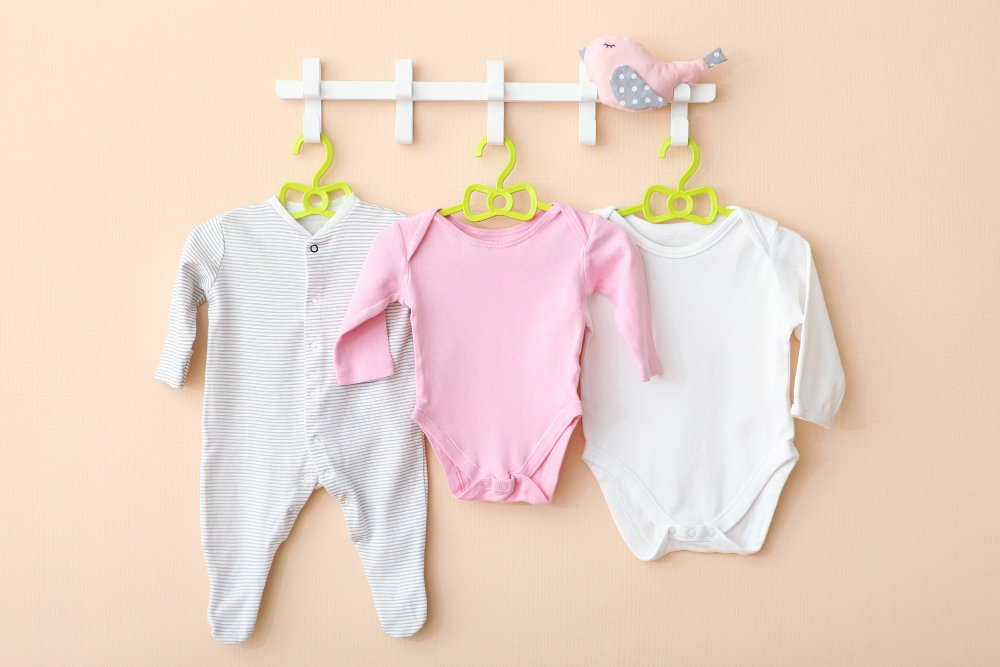
Comfort and safety should always be your top priority when choosing your baby’s clothes. Your infant’s sensitive skin needs gentle, non-irritating materials that allow proper air circulation and temperature regulation.
Best Fabric Choices for Baby Skin
Cotton is the ideal choice for your baby’s clothing. It’s breathable, soft, and helps regulate body temperature naturally. For babies with extra sensitive skin, consider hypoallergenic materials like organic cotton or bamboo rayon.
2025 Sustainable Fabric Trends
Parents are increasingly choosing eco-friendly options like organic cotton, bamboo fiber, and TENCEL™. These materials for children’s clothing are not only gentler on baby’s skin but also better for the environment.
Layering is Essential
Layering is key for all seasons. Start with a light, breathable base layer against your baby’s skin. Add or remove layers as needed based on temperature changes throughout the day.
Essential Items for Every Season:
- 6-8 onesies or bodysuits
- 4-6 pairs of pants or leggings
- 3-4 light sweaters or jackets
- 4-5 pairs of socks
- 2-3 hats for different weather conditions
Temperature Check Tip: Check your baby’s temperature by touching the back of their neck. If it’s sweaty, remove a layer. If it feels cool, add one. This is more reliable than checking hands or feet.
Age-Specific Clothing Guide
Your baby’s clothing needs change significantly as they grow and develop. Here’s what to focus on for each age group:
Newborn (0-3 months)
- Easy diaper access: Snap crotches and wrap-style tops
- Soft seams: Look for flat or rolled seams
- Kimono-style tops: Easier than over-the-head styles
- Mittens: Prevent scratching
- Footed sleepers: Keep tiny feet warm
Understanding newborn vs infant sizes helps you buy the right fit.
Infant (3-12 months)
- Crawling-friendly: Reinforced knees on pants
- Snap crotches: Still important for easy changes
- Stretchy fabrics: Allow freedom of movement
- No loose parts: Avoid buttons or decorations that can come off
- Non-slip socks: For babies starting to stand
Toddler (12+ months)
- Walking considerations: Flexible shoes with good grip
- Independence features: Elastic waistbands, large openings
- Durable fabrics: Can withstand active play
- Easy-wash materials: Stain-resistant when possible
- Weather protection: Proper outerwear for outdoor exploration
Learn more about essential toddler clothing items for active little ones.
What Size Do Babies Wear the Longest?
Babies typically wear 3-6 month sizes the longest, usually for about 2-3 months. Newborn sizes are often outgrown within 4-6 weeks, while 6-12 month sizes can last 3-4 months. When deciding between 0-3 months or 3-6 months, choose 3-6 months unless your baby is particularly small.
| Size | Weight Range | Typical Duration | Key Features |
|---|---|---|---|
| Newborn | 5-8 lbs | 2-6 weeks | Hospital outfit, first photos |
| 0-3 months | 8-12 lbs | 6-10 weeks | Early development stage |
| 3-6 months | 12-16 lbs | 2-3 months | Most cost-effective size |
| 6-12 months | 16-22 lbs | 3-4 months | Crawling and sitting up |
How Many Outfits Does a Newborn Need?
For newborns, plan for 3-4 outfit changes per day. You’ll need:
- 8-10 onesies or bodysuits
- 6-8 sleepers or gowns
- 4-6 pants or leggings
- 2-3 going-home outfits in different sizes
- 1-2 special occasion outfits
Spring Baby Clothing
Your baby needs adaptable clothing for spring’s changing temperatures. Spring clothes should combine lightweight fabrics with smart layering options to handle morning chill and afternoon warmth.
Layering Pieces for Variable Weather
Lightweight cotton bodysuits serve as the perfect base layer for spring wardrobes. Choose short-sleeve styles for warmer days and long-sleeve options for cooler mornings.
(15-21°C)
- Long-sleeve onesie
- Light pants or leggings
- Cotton cardigan (easy to remove)
- Light socks
- Sun hat for outdoor time
How to Dress a Newborn in Spring
Spring weather can be unpredictable, so dress your newborn in layers you can easily adjust:
- Base layer: Cotton bodysuit or onesie
- Middle layer: Light sweater or cardigan
- Outer layer: Light jacket or blanket for cooler moments
- Accessories: Soft hat and socks
Spring Layering Essentials:
- Breathable cotton bodysuits
- Lightweight cotton pants
- Elastic-waist leggings
- Thin cotton socks
- Adjustable cotton hats
Essential Light Jackets and Cardigans
A lightweight cotton cardigan offers perfect coverage for mild spring days. Choose button-front styles for easy dressing and removal.
Spring jackets should be water-resistant but not too heavy. Look for styles with hoods to protect against unexpected rain showers.
2025 Spring Trends for Babies
- Soft pastels: Mint green, lavender, pale yellow
- Floral prints: Small, delicate patterns
- Scalloped edges: On collars and sleeves
- Organic cotton: Sustainable and soft
Key Features for Spring Outerwear:
- Zip-up fleece jackets
- Button-front cardigans
- Hooded windbreakers
- Light cotton sweaters
Keep jackets one size larger to fit over layered clothing comfortably. This allows room for growth while maintaining mobility.
Summer Wardrobe Essentials
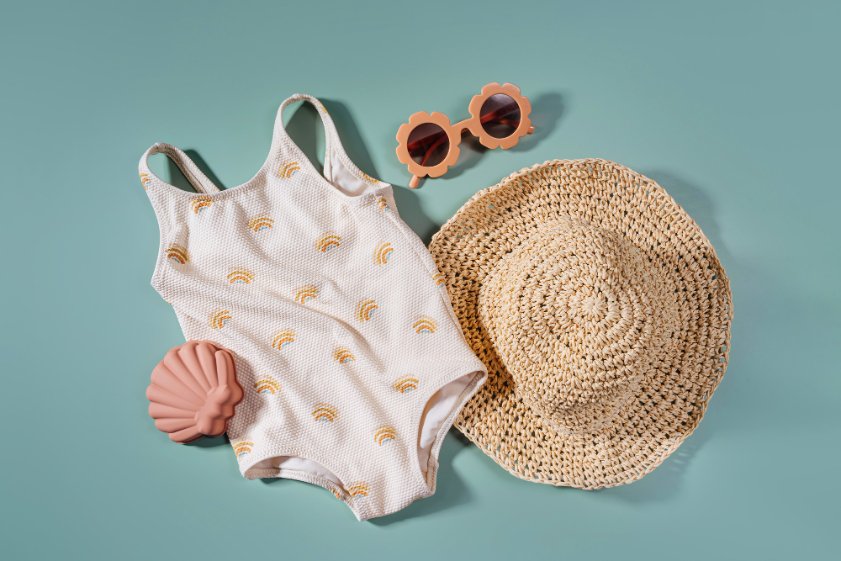
Dressing your baby for hot weather requires light, breathable fabrics and comfortable styles that keep them cool while protecting their sensitive skin from harmful UV rays.
Expert guidance on dressing babies for different seasons and recognizing temperature cues
How to Dress a Newborn in Summer
In hot weather, less is often more for newborns:
- Indoors (70-75°F): Just a diaper and light onesie
- Outdoors: Add sun protection with long sleeves and hat
- Car travel: Light clothes plus sun shade for windows
- Air conditioning: Have a light blanket ready
Do Newborns Need Long Sleeves in Summer?
Yes, long sleeves are important for sun protection when outdoors. Choose ultra-light, breathable fabrics with UPF protection. Indoors or in shade, short sleeves are fine.
(24-29°C)
- Light cotton onesie or romper
- Sun hat with wide brim
- Light cotton socks (no shoes needed indoors)
- Sunglasses for babies 6+ months
What Should My Baby Wear Home from the Hospital in July?
For a July hospital discharge, pack:
- Light cotton onesie (short or long sleeve)
- Thin cotton pants or a romper
- Light receiving blanket
- Soft cotton hat
- One backup outfit in the next size up
Sun Protection Essentials
Your baby needs extra protection from harmful UV rays during summer outings. Select lightweight cotton outfits that cover arms and legs without causing overheating.
Wide-brimmed sun hats with neck coverage are essential for outdoor activities. Look for hats with UPF 50+ protection and adjustable chin straps.
Eco-Friendly Summer Tip: Choose rompers and onesies made from organic cotton, bamboo fabric, or muslin. These natural materials are better for baby’s skin and the environment.
Keep a light muslin blanket handy for stroller shade or nursing cover. This adds an extra layer of sun protection without trapping heat.
Comfortable and Cool Footwear
Baby feet need proper ventilation in hot weather. Soft cotton socks paired with breathable shoes prevent sweating and discomfort.
Select sandals with these features:
- Flexible soles
- Adjustable straps
- Breathable materials
- Closed toes for protection
Skip shoes entirely for indoor time. Let your baby’s feet breathe when at home or in safe indoor environments.
Consider water-friendly shoes for pool or beach visits. These protect tiny feet from hot surfaces while allowing quick drying.
Autumn Clothing Guide

Dressing babies for fall requires strategic layering and proper footwear to handle temperature swings between warm days and cool nights.
How to Dress a Newborn in Fall
Fall layering for newborns should be flexible and easy to adjust:
- Base: Long-sleeve bodysuit
- Layer 2: Pants or leggings
- Layer 3: Cardigan or light sweater
- Outer: Light jacket or coat for outdoors
- Accessories: Hat and socks
(10-18°C)
- Long-sleeve cotton onesie
- Pants or thick leggings
- Light sweater or cardigan
- Warm socks
- Knit hat
Transition Pieces for Changing Temperatures
Your baby needs versatile pieces that work together as temperatures shift. Start with a soft cotton onesie as the base layer against your baby’s skin.
Fall Layering Pieces:
- Cotton cardigans
- Zip-up hoodies
- Light sweaters
- Long-sleeve bodysuits
Keep a thin jacket or fleece vest handy for outdoor activities. Remove layers quickly when your baby shows signs of overheating.
Roll up sleeves or pant legs on warmer days. Choose stretchy fabrics that allow freedom of movement as your baby crawls and explores.
2025 Fall Baby Fashion Trends
- Earth tones: Warm browns, deep oranges, forest greens
- Plaid patterns: Classic fall prints
- Cozy textures: Knits and fleece
- Layered looks: Vests over long sleeves
Footwear for Pre-Winter Months
Your baby’s feet need protection from cooling temperatures while maintaining stability for crawling and early walking stages.
Soft booties with non-slip soles work well for crawlers. Choose options with:
- Elastic ankles to stay in place
- Flexible soles for natural movement
- Breathable materials
- Hook-and-loop closures for easy on/off
Lightweight sneakers support new walkers on cool days. Pick shoes with wide toe boxes and flexible soles to aid natural foot development.
Winter Baby Clothing
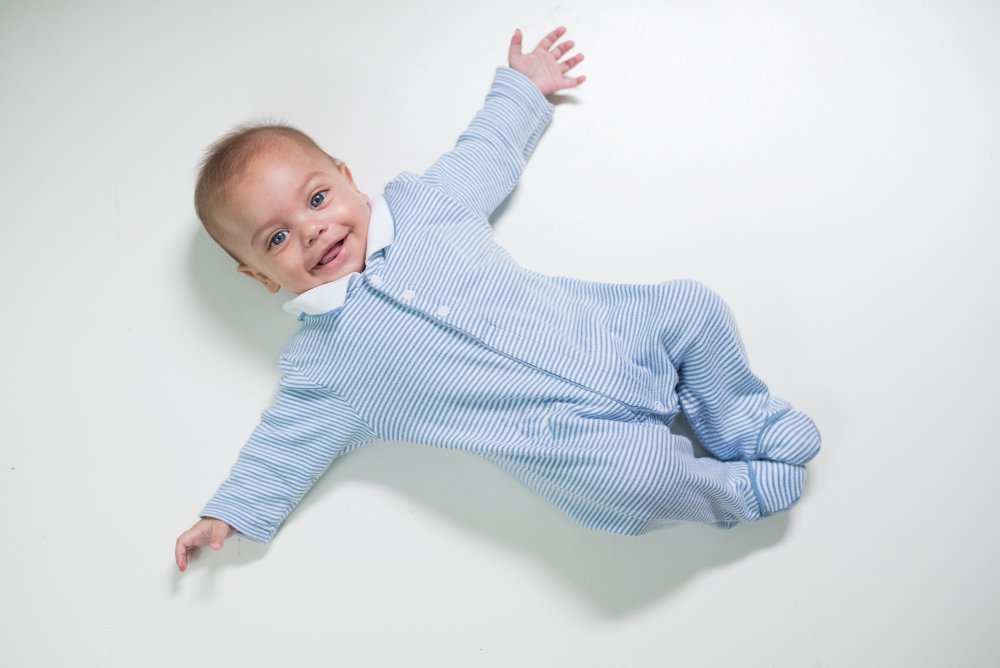
Protecting your baby from cold weather requires specific clothing items that provide warmth and comfort. Focus on layering options that keep your infant cozy without overheating.
How to Dress a Newborn in Winter
Winter dressing for newborns follows the rule of one extra layer than what you’re wearing:
- Base layer: Thermal bodysuit or long-sleeve onesie
- Middle layer: Warm sleeper or outfit
- Outer layer: Bunting suit or thick coat
- Extremities: Hat, mittens, warm socks
(Below 4°C)
- Thermal long-sleeve bodysuit
- Warm footed sleeper
- Winter coat or bunting
- Warm hat covering ears
- Mittens and warm socks
What Do Babies Wear Right After Birth in Winter?
For winter hospital stays, bring:
- Warm long-sleeve onesie
- Footed sleeper or gown
- Warm receiving blanket
- Knit cap
- Car seat-safe bunting or coat
- Extra blankets for warmth
Warm Bodysuits and Sleepwear
Sleep sacks and warm swaddles keep your baby snug during nighttime and naps. Choose breathable materials like cotton with a higher TOG rating for winter.
What Does TOG Mean in Baby Clothes?
TOG (Thermal Overall Grade) measures how warm a garment keeps your baby:
| TOG Rating | Room Temperature | What Baby Should Wear |
|---|---|---|
| 0.5 TOG | 75°F+ (24°C+) | Diaper + sleep sack |
| 1.0 TOG | 70-75°F (21-24°C) | Light onesie + sleep sack |
| 2.5 TOG | 61-68°F (16-20°C) | Long-sleeve onesie + sleep sack |
| 3.5 TOG | Below 61°F (Below 16°C) | Warm pajamas + sleep sack |
Dress your baby in thermal bodysuits as a base layer. These trap heat close to the skin while wicking away moisture.
Footed pajamas provide full-body coverage and eliminate the need for separate socks. Pick ones with zip closures for easy diaper changes.
What Should a Baby Wear to Bed?
Safe sleep guidelines from the Mayo Clinic recommend:
- No loose blankets: Use sleep sacks instead
- Right TOG rating: Based on room temperature
- Proper fit: Not too tight or loose
- Check temperature: Feel baby’s chest or back of neck
How to Tell if Baby is Cold at Night
Check these signs to see if your baby needs more warmth:
- Feel the back of their neck or chest
- Cool skin indicates they need another layer
- Mottled or blotchy skin can mean they’re cold
- Fussiness when other needs are met
- Hands and feet are naturally cooler, so don’t use them as indicators
Cold Weather Accessories
Babies lose significant body heat through their heads, making warm hats essential for outdoor trips. Choose soft, stretchy materials that stay in place.
Keep tiny hands warm with mittens that have elastic wrists. These prevent scratching while maintaining proper temperature.
Soft booties or shoes protect little feet and stay warmer than regular socks. Look for non-slip soles if your baby is starting to walk.
Should I Cover My Baby’s Hands at Night?
Generally, you don’t need to cover baby’s hands at night unless the room is very cold (below 65°F). If needed, use:
- Built-in mittens on sleepers
- Sleep sacks with hand covers
- Scratch mittens if baby scratches their face
Sustainable and Eco-Friendly Options
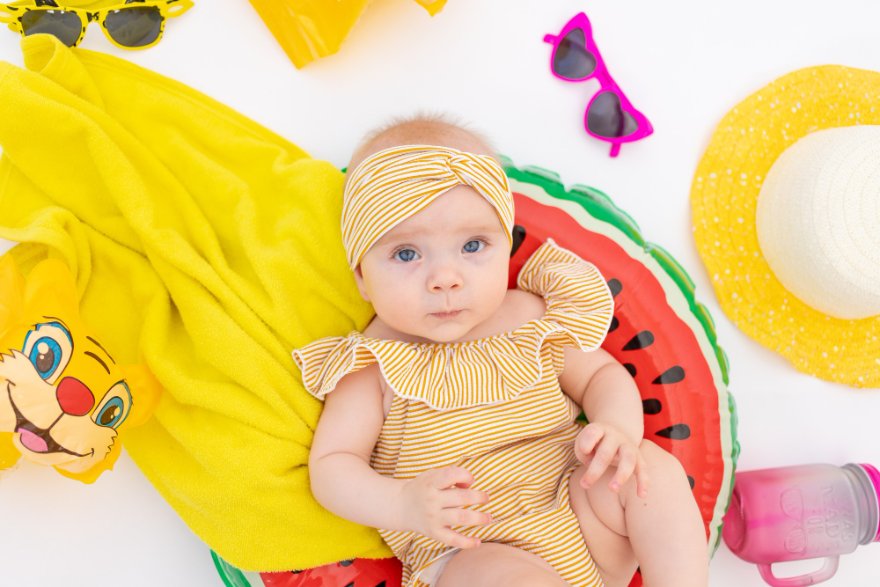
Parents today are increasingly choosing sustainable baby clothing options that are better for both their baby’s health and the environment.
Organic and Natural Fabric Benefits
Organic cotton, bamboo, and hemp are becoming popular choices for baby clothes. These materials are:
- Chemical-free: No harmful pesticides or dyes
- Hypoallergenic: Less likely to cause skin reactions
- Biodegradable: Better for the environment
- Durable: Last longer through multiple washes
Eco-Tip: Look for GOTS (Global Organic Textile Standard) certification when buying organic baby clothes. This ensures the highest environmental and social criteria. Recent studies by the Environmental Working Group have found concerning levels of toxic chemicals in some baby textiles, making organic choices even more important.
2025 Sustainable Trends
What’s Trending in Sustainable Baby Fashion
- TENCEL™ fabrics: Made from sustainable wood sources
- Recycled materials: Clothes made from recycled plastic bottles
- Natural dyes: Plant-based colors
- Gender-neutral designs: Can be passed down to any sibling
- Modular clothing: Pieces that grow with your baby
Smart Shopping for Sustainability
Making sustainable choices doesn’t have to break the budget:
- Buy fewer, higher-quality pieces
- Choose neutral colors that work for any gender
- Look for adjustable features like extendable sleeves
- Consider second-hand options
- Invest in pieces that can be handed down
Care and Maintenance of Baby Clothes

Proper washing and care keeps baby clothes clean, safe, and lasting longer. Always check clothing labels for specific care instructions before washing.
Washing Guidelines
Use mild, fragrance-free detergent made for sensitive skin. Wash new clothes before your baby wears them to remove any chemicals or irritants.
Sort clothes by color and wash them separately from adult laundry. Use warm water for white items and cold water for colored clothing to prevent fading.
Important Washing Tips:
- Pre-treat stains immediately
- Fasten all buttons and zippers
- Turn clothes inside out
- Avoid fabric softeners
- Air dry when possible
Can Baby Clothes Go in the Dryer?
Most baby clothes can go in the dryer, but check care labels first. Use low heat settings to prevent shrinking and damage to delicate fabrics.
Storage and Organization
Store clean clothes in a dry place away from direct sunlight. Fold items neatly or hang them to prevent wrinkles and damage.
Keep seasonal items organized in separate storage containers. Label each container clearly and rotate clothing as the seasons change.
Check clothes regularly for loose buttons, worn elastic, or damaged snaps. Fix small issues quickly to keep clothes safe and comfortable for your baby.
Safety and Comfort Guidelines

Choosing safe and comfortable clothing helps protect your baby’s delicate skin while keeping them at the right temperature.
Choosing Safe Fabrics and Fits
Pick soft, breathable fabrics like cotton that won’t irritate your baby’s sensitive skin. These materials let air flow and help prevent overheating.
Make sure clothes fit properly – not too tight or too loose. Tight clothes can restrict movement and breathing. Loose clothes pose a safety risk from tangling.
The 5-8-5 Rule for Babies
The 5-8-5 rule is a helpful guideline for baby clothing quantities:
- 5 days: Have enough clothes for 5 days without washing
- 8 changes: Expect up to 8 outfit changes per day for newborns
- 5 sizes: Keep clothes in 5 different sizes as babies grow quickly
What to Dress a Baby in Daytime vs. Night
Daytime and nighttime clothing needs differ:
Daytime Clothing:
- Easy-change outfits for frequent diaper changes
- Comfortable fabrics for active play
- Weather-appropriate layers
- Clothes that allow freedom of movement
Can Babies Wear Sleepsuits in the Day?
Yes, babies can wear sleepsuits during the day, especially newborns who sleep most of the time. Sleepsuits are comfortable and practical for home wear.
Do Babies Need Pants (Underwear) with Onesies?
Babies don’t wear traditional underwear. For infants in diapers:
- Onesies alone: Fine for warm weather indoors
- Add pants: For cooler weather or going out
- Footed onesies: Provide full coverage
- Diaper covers: Can add extra protection over onesies
When to Put Baby in Pajamas
Start a bedtime routine with pajamas around 2-3 months when sleep patterns begin to develop. This helps signal bedtime and creates healthy sleep associations.
Weather-Appropriate Clothing Selection
Layer clothes to manage your baby’s temperature in changing conditions. Add or remove layers as needed.
In cold weather, use multiple thin layers rather than one thick layer. This traps warm air between layers while allowing better movement.
What to Dress a Baby in 20 Degrees During the Day
For 20°C (68°F) weather:
- Long-sleeve cotton onesie
- Light pants or leggings
- Socks
- Light cardigan for breezy conditions
- Sun hat if outdoors
For hot weather, dress your baby in lightweight, loose-fitting clothes. A single layer of breathable fabric often works best.
Temperature Guidelines:
- Dress your baby in one more layer than you’re wearing
- Check their neck – if sweaty, remove a layer
- Make sure ears and hands stay covered in cold weather
- Watch for signs of overheating like flushed cheeks or rapid breathing
Smart Shopping and Sizing Tips
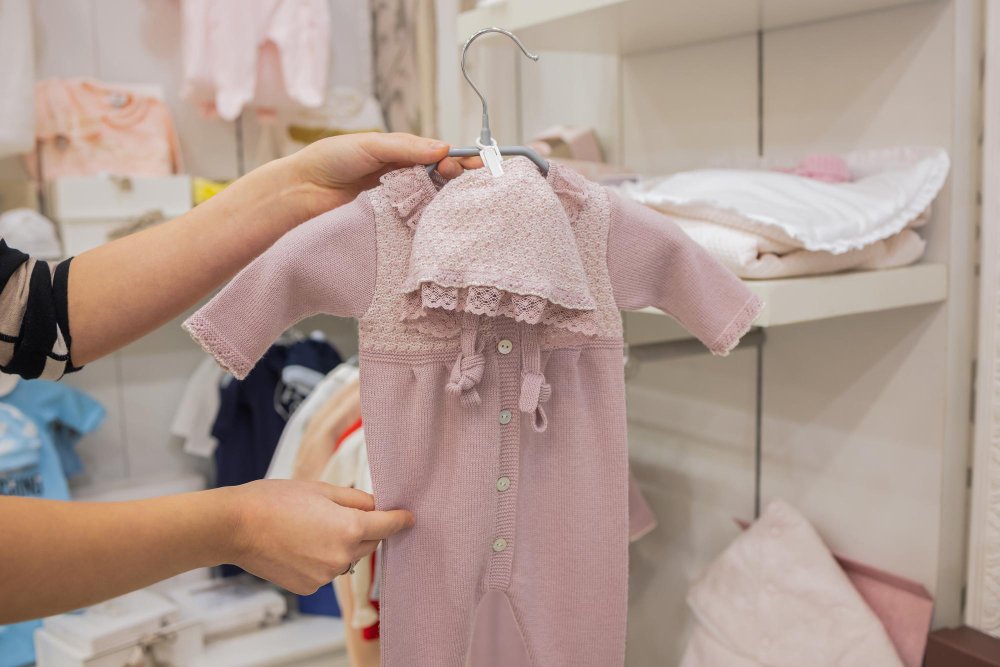
How to Dress a Baby Immediately After Birth
For your hospital bag, pack clothes in multiple sizes:
- Newborn and 0-3 month sizes
- Easy-to-put-on kimono-style tops
- Footed sleepers or gowns
- Receiving blankets
- Soft hat and mittens
Is 0-3 Months the Same as Newborn?
No, they’re different sizes:
- Newborn: 5-8 lbs, up to 21 inches
- 0-3 months: 8-12 lbs, up to 24 inches
Many babies skip newborn sizes entirely, so don’t buy too many.
Budget-Friendly Shopping Tips
- Focus on basics: onesies, sleepers, and pants
- Buy versatile pieces that work across seasons
- Consider selling outgrown clothes to fund new purchases
- Shop end-of-season sales for next year
- Join clothing swaps with other parents
Money-Saving Tip: Babies grow fastest in their first few months. Buy fewer clothes in smaller sizes and more in 6-12 month sizes.
Frequently Asked Questions
A well-rounded winter baby wardrobe includes 6-8 long-sleeve onesies, 4-5 warm sleepers, 3-4 pairs of warm pants, 2-3 sweaters, and a thick winter coat or bunting suit. Don’t forget 2-3 warm hats, several pairs of socks, and waterproof booties for outdoor trips.
For room temperatures between 68-72°F, dress your baby in a long-sleeve onesie with a sleep sack. Add warm footed pajamas when temperatures drop below 68°F. For warmer rooms above 72°F, a short-sleeve onesie with a lightweight sleep sack works best.
Stock up on 6-8 lightweight, breathable onesies made from soft fabrics. Include 3-4 pairs of shorts, 2-3 light rompers, and a sun hat with UV protection. Keep 2-3 light blankets and cotton sleepers for air-conditioned spaces.
Layer a long-sleeve onesie under warm clothes for indoor comfort. Add a fleece or wool sweater and insulated pants for outdoor trips. Use a warm hat, mittens, and booties to protect extremities from cold.
Dress your baby in one more layer than what you’re wearing for indoor activities. For outdoor time, start with a base layer, add warm middle layers, and finish with a weather-appropriate outer layer. Check your baby’s neck regularly – if it’s sweaty, remove a layer.
Conclusion
Creating the perfect seasonal wardrobe for your baby doesn’t have to be overwhelming. By focusing on comfort, safety, and adaptability, you can build a practical collection that keeps your little one comfortable year-round while supporting their development and your budget.
Key Takeaways and Recommendations
Prioritize Quality Over Quantity: Invest in well-made basics like cotton onesies, versatile pants, and adaptable layers. These pieces will last longer and provide better value than trendy items that quickly wear out.
Think Sustainable: Choose organic cotton, bamboo, and other eco-friendly materials when possible. These fabrics are gentler on your baby’s skin and better for the environment. Look for gender-neutral colors and styles that can be passed down to siblings.
Safety First, Always: Check clothing regularly for loose buttons, worn seams, and proper fit. Remember that baby clothing should never have small parts that could pose choking hazards, and sleep clothes should follow safe sleep guidelines.
Age-Appropriate Choices Matter: Newborns need easy-access clothing with kimono styles and snap crotches. Crawling babies benefit from reinforced knees and flexible fabrics. Toddlers need durable clothes that support their active lifestyle and growing independence.
Seasonal Adaptation is Essential: Each season brings unique challenges. Spring requires versatile layering pieces, summer demands sun protection and breathability, fall needs transitional items, and winter calls for proper insulation without overheating.
Smart Shopping Strategies: Buy fewer newborn sizes since babies outgrow them quickly. Focus your investment on 3-6 month and 6-12 month sizes. Take advantage of end-of-season sales and consider second-hand options for both budget and environmental benefits.
Proper Care Extends Life: Use gentle, fragrance-free detergents and follow proper washing techniques. Air dry when possible and store clothes properly to maintain their quality and safety.
Remember, every baby is different, and what works for one family might not work for another. Pay attention to your baby’s cues, adjust clothing based on their comfort, and don’t hesitate to modify recommendations based on your specific climate and lifestyle needs.
Building a thoughtful seasonal wardrobe is an investment in your baby’s comfort, your peace of mind, and often your family’s budget. By following these guidelines and adapting them to your unique situation, you’ll be well-equipped to keep your little one comfortable, safe, and stylish through every season of their early years.
For more helpful guides on baby and toddler clothing, explore our other resources on essential newborn clothing and toddler wardrobe basics.
Continue exploring our comprehensive guides on fabric care, sewing techniques, and fashion trends to enhance your knowledge of clothing and textiles.

